► Rear-drive supercars driven
► Audi takes on McLaren
► Which one is best?
The matrix boards flashed severe weather warnings when I pointed the Audi R8 north up the A1 last night, on towards Kielder Water. Those warnings gave just a day to bag this drive, but next morning the weather’s creeping in: flecks of snow dance over the road as it stretches up past the reservoir, hypnotic like static interference on a television, thankfully melting away quickly into the frostbitten surface.
Temperatures hover around zero as we push over the border into Scotland. Timber lorries bustle past in noisy, turbulent assaults, coating the road with clag dragged from clear-cut hillsides. Thick initially, the mud bleeds to almost nothing a few corners later, like a corpse pulled from a diner in a mafia thriller. Grip up here is tricky, but the draw is roads that endlessly coil and challenge, and so little traffic that the clear-cutting could be mistaken for some devastating nuclear aftershock.
The Audi’s V10 thrums away sweetly behind me, its range rising from the smooth bass of lower revs to a vicious high-rpm wail that’d make a modern F1 driver swoon – and instils just a little fear when you unleash the 8000rpm fury.
We’re keeping up a good pace, CAR features brain James Taylor in the McLaren 570S behind, the Brit’s V8 boosty and gruff and sci-fi futuristic all at the same time, its chassis so intimately communicating road-surface texture that there’s no fear in smearing its tyres delicately over the modest limits. ‘It’s that cocktail-stick feeling,’ says JT, ‘like there’s one stuck in the centre of the car around which everything pivots.’
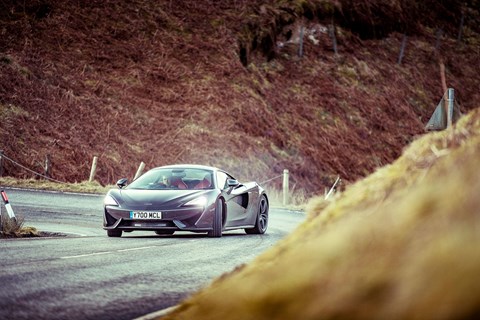
Normally, these conditions tip the balance in favour of quattro all-wheel drive. But switch off all the Audi’s electronic guardians, carry some speed into a corner, pin the accelerator early and our R8 will drift through the apex like no Audi you’ve ever experienced before. That’s because this is the Audi R8 RWS, or Rear-Wheel Series, Audi’s first ever rear-wheel-drive production model.
Not long ago, the RWS would’ve been impossible. Audi’s performance division was called Quattro GmbH, a name synonymous with all-wheel-drive technology proven in part on the forest rally stages around here. Hot Audis had to be
all-wheel drive. But in late 2016, ex-Lamborghini main man and then Quattro boss Stephan Winkelmann re-christened the division Audi Sport, paving the way for high-performance Audis to unshackle their front driveshafts like they’d discovered the key to a chastity belt.
Available as a Coupe or Spyder, the R8 RWS is the first; the lightest, purest R8 you can buy, its ditched hardware contributes to a 50kg reduction over all-wheel-drive variants – 1590kg for our Coupe. There’s the same 5.2-litre naturally aspirated V10 with 533bhp as the non-Plus R8 quattro, so the power-to-weight ratio is improved by 10bhp, though the traction-limited 0-62mph sprint drops a couple of tenths to 3.7 seconds.
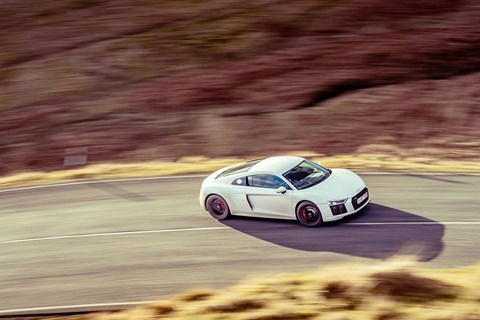
The RWS template was already there, of course: the Lamborghini Huracan – from which the R8 is spun – is available with rear-drive. Audi also points out that its R8 LMS GT3 racer is rear-drive, if not that racing regulations forced its hand.
Like Lamborghini, Audi positions the R8 RWS at the gates to R8 ownership. Priced from £112,450, it’s almost £14k cheaper than the quattro R8 (almost £29k cheaper than the Plus) and options like Dynamic steering (normally £1200), adaptive dampers (£1600) and ceramic brakes (£7700) are unavailable. Our test car gets a relatively restrained £4k of options; £1800 goes on a sports exhaust to unleash all kinds of sonic majesty, particularly the deeply rich tones unlocked in Dynamic mode.
Just 999 examples of the RWS are being assembled almost entirely by hand at Audi Sport’s Böllinger Höfe facility. Could it be that the cheapest R8 is also the best? Fact is, there just isn’t anything comparable at this end of the market, other than the £43k costlier, bit-too-similar Huracan.
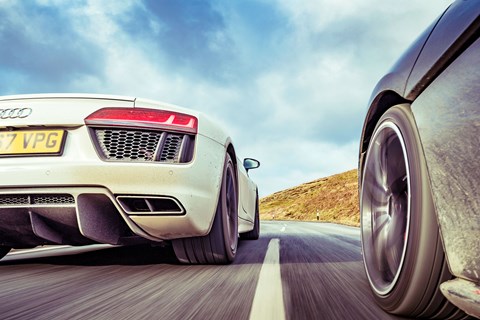
The McLaren 570S comes close, and easily wins the showroom showdown. Bystanders gravitate towards its cab-forward, nose-down, low-slung proportions that immediately communicate sporting intent and supercar otherworldliness.
Like Audi tapping into the benefits of its ownership of Lamborghini, economies of scale trickle down to the 570S. It’s built around the same carbon cell as the recently replaced and significantly more expensive 650S, and borrows the same dual-clutch gearbox and 3.8-litre twin-turbo V8. The latter is de-tuned by 79bhp, if still good for 3.2 seconds to 62mph.
The 570S costs from £149,000, but there is an even more relevant McLaren, the modestly de-contented 540C. It’s yours for a slightly more comparable £135k and serves up the exact same 533bhp as the R8 RWS. But just as most UK buyers upgrade to the 570S, so too have we. We’ll cut the R8 slack for that.
You reach under the suspension-bridge-like beam that spans the McLaren’s dihedral door, lift it up and peer into a cabin that looks minimalist if intensely driver-focused all the same – though spoiled by our car’s interior drawing inspiration from a highly aroused baboon. Step over a chunk of (carpeted) carbonfibre sill a handspan wide, and you sink into seats
dramatically low on the floor, accelerator pedal close to the carbon tub, brake pedal dead ahead of your left foot.
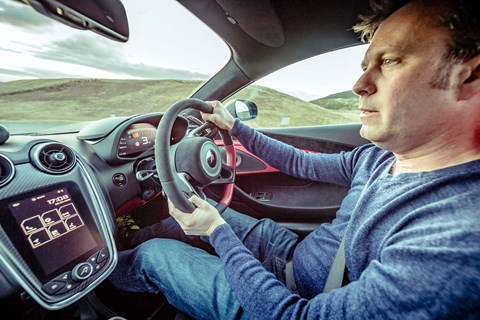
The McLaren instantly feels special, no matter how slowly you drive. Carve up through these hillsides and its hydraulically assisted steering is fast-paced, weighted modestly enough to make the car feel sparky and nimble, if heavy and consistent enough to contextualise lateral loads building through the suspension. Thin, solid and wrapped in alcantara, the wheel trembles continually with delicious analogue feedback.
The chassis is equally tactile. The track feels wide, the centre of gravity low, and despite a more conventional set-up than the inter-connected dampers of pricier McLarens, the 570S still pulls off that Woking witchcraft of zinging the road surface out in unfiltered detail, yet shushing bumps too. The carbon tub contributes to a kerbweight some 138kg fleeter than the Audi’s, and you feel that lack of mass in the energy of its direction changes, and how weight transfer is so expertly controlled through quick corners and under heavy braking.
Today’s supercars are in another league of demented performance, so the 570S – billed a Sports Series by McLaren – feels more manageably fast in comparison, and yet it’s still riotously quick, still powers past traffic like Gulliver striding over Lilliputians, and still feels restless when you try to keep it below 90mph on the autobahn. Its delivery is pretty thuggish too: almost entirely without a pulse at low revs, there’s a snap of boost at around 3500rpm that sends shockwaves through the rear rubber if it’s damp, and a hold-on-tight run to a manic 7400rpm when you find the space and courage to give the V8 its head. Intense doesn’t quite cover it.
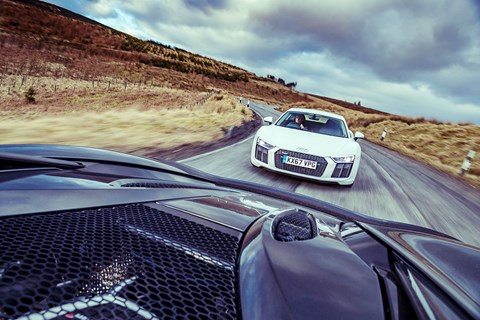
But after the clarity of the suspension and steering, there’s a fuzz to the McLaren’s powertrain like a camera a fraction out of focus. The throttle has a certain mush to its travel, and while the gearshifts are quick and bang down through multiple ratios eagerly, there’s a small disconnect between you clicking the carbonfibre paddleshifter and something mechanical actually happening.
The standard carbon-ceramic brakes betray a similar blurriness, though other 570s I’ve driven felt better. It’s not that their outright stopping power is in doubt, because they’ll stop the McLaren like security spotting Ron running through4=
the McLaren Technology Centre, but there’s an inch or so of travel where the feel is nebulously defined, so you press harder and they suddenly wake up.
There’s another, more causal counterpoint to the vivid immediacy streaming through the McLaren driver’s palms: a more highly strung feeling on longer journeys. The seats are great, the ride fantastic, but that carbon tub, Pirelli P Zeros that measure 19 inches up front, 20 at the rear, and the firm suspension bushings transmit road noise like breakers hitting the beach. And because McLaren is a low-volume producer, the infotainment is unintuitive and patchy.
There’s no doubt that the Audi does the daily stuff better, and perhaps that’s what dilutes its specialness, why people pass it by like it’s a TT and gawp at the McLaren; the R8’s more rounded, no matter that the more knowledgeable will be dumbstruck by the V10 showcased through the rear window, or know that the aluminium body has a rigid carbonfibre transmission tunnel and rear bulkhead like a capital T at its core.
You open the door with a conventional – boring! – door handle, it swings open in – yawn! – the normal way, and you sit in a nice seat spoiled by what feels like a command driving position after the McLaren. The upside of all this sensibleness crystallized as I took that late-night run up the A1: less road noise permeates the Audi’s cabin from its 19-inch P Zeros, and you get the virtual cockpit and all the intuitive logic of Audi’s MMI-based infotainment. If you want to chat to your passenger and not get lost as you drive somewhere, there’s appeal in that. Many people do.
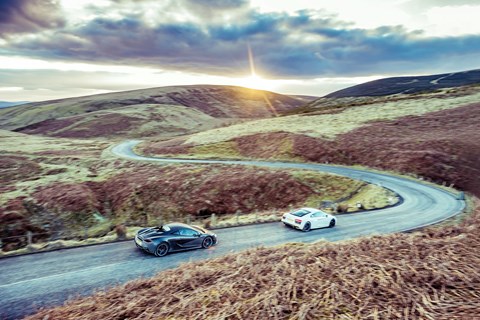
The only chink in the Audi R8’s daily-driver armoury is
its ride quality. Clearly, with only 999 units – and Coupes and Spyders carved out of that number with different set-up requirements – tuning passive and adaptive dampers wouldn’t have made sense. So passive dampers it is, meaning the
Audi must strike a compromise where the McLaren’s adaptive set-up allows it to morph from long-distance comfort to apex destroyer. At times, whether at low speed in town or during faster runs on the A1, the R8’s damper travel is too choppy.
But on the fast, smoother roads that flow north of Kielder, they’re very effective, controlling the body neatly, but always allowing the breathing space to build a rhythm.
There’s no escaping that the McLaren has the more communicative steering and chassis, though. There’s less surface information to process, less raw energy to how the R8 changes direction, and more body roll too. But the RWS is still very sweetly balanced.
The 50kg reduction isn’t particularly noticeable in itself, but the effects of losing the driveshafts are more transformative on the steering. There’s still gloopiness to push through off-
centre, but no longer does it stiffen when you accelerate hard from corners – a benefit of torque no longer being channelled to the front axle and corrupting the linearity of the steering.
The McLaren feels quicker, partly because it wins the power-to-weight war with 387bhp per tonne to the Audi’s 335bhp per tonne, but also because its turbocharged delivery is full of violence. But the Audi’s naturally aspirated V10 is better. It still hauls hard from low revs, no matter that the relatively modest 398lb ft takes 6500rpm to kick in, and there’s an intoxicating second wind that bursts in from around 6000rpm and surges towards 8000rpm like a 1500-metre runner mugging everyone at the finish. That final hurrah sounds inconsequential when I tap it into a keyboard, but when you’re in the meat of it, consumed by the mechanical ferocity of it all, feeling the R8 gather pace like a rollercoaster suddenly falling faster than expected, well, it becomes almost the entire point. Yes, it lacks the mad adrenaline rush served up by the faster R8 Plus, but give a specialist like Litchfield Motors £1200 and they’ll magic that difference away with an easily reversible tweak.
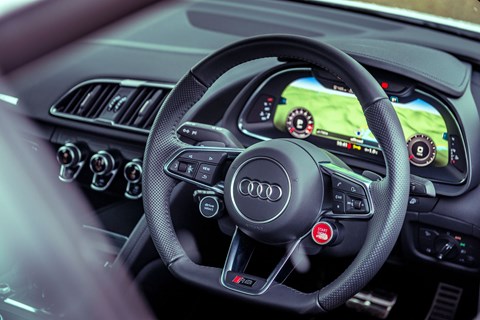
Perhaps the purity of this concept deserves a manual gearbox but the S-tronic gearbox is punchy and smooth, even if it does strangely interrupt engine braking during downshifts, like there’s a little slip.
For all its disruptive rear-wheel-driveness, one thing remains very much Audi: the stability control. It allows so little slip in its default4
setting that leaving a junction can be a struggle, and while you can relax that by progressing up through to Dynamic mode, you can still sense the hand-wringing in Ingolstadt.
It’s this, along with the confidence-inspiring linearity of the V10, that encourages me to disengage the R8’s electronic systems first. The threat of snow has melted away, and
early-evening sunshine glows over the landscape, leaving the road smeared with a palette of greys and whites and blacks.
I run up the hillside quickly and fall completely under the RWS’s spell. Lean hard on the front end as you carve into a corner until you feel the front tyres squirm, back off the throttle quickly, and you sense the R8 is keen to rotate into oversteer – you’ve already set a pendulum in motion, and the weight of the V10 does its best to continue it. Wind on opposite lock and accelerate and you’ll crack open that final layer of involvement that the RWS perhaps hides on first acquaintance. It helps that there’s bandwidth to this engine like a yo-yo on a extra long piece of string. It’ll loosen the rear end with what feels like just a few thousand rpm on the dial, and then stretch on and on as the rear tyres spin up, the engine smooth if wavering just a little at the highest notes, like a Clapton vibrato riding into squalls of feedback. It’s such a refreshing balance after the all-wheel-drive version, which turns manically neutral given similar treatment and hauls itself out by the front driveshafts.
Truth is you take a deeper breath before turning off the McLaren’s stability control – and endure more faffing to get there. There’s a more neutral feeling to the McLaren’s chassis, a sense that you can overstep the limits and then retreat, where the R8 driver battles more weight transfer once committed.
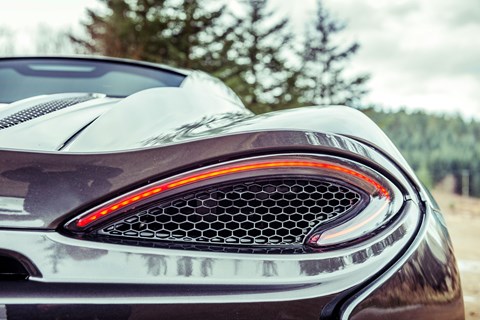
Less progressive is the McLaren’s power delivery – catch it off-boost and the rear end remains stubbornly inert, but get the fuse lit and the oversteer needs a quick response. The McLaren still feels benign and trustworthy at the limit, and it’s hard not to be sucked in by the burning intensity of its delivery. Ultimately, though, it’s more enjoyable to thread the McLaren fast and smooth cross-country, easing in and out of the throttle, marvelling at the pace you can keep up, feeding off the messages filtering up through its chassis and tyres.
We run on into the darkness, our convoy moving further north into Scotland, headlights flicking over the fast crests and dips that run through the evergreens. It’s an intense journey, the brief respite of a T-junction broken when the sat-nav instructs us to follow the road for 39 more miles. I laugh out loud. Thirty nine more miles of this? In these cars? Oh, go on then.
The McLaren 570S blends analogue feedback with digital performance to deliver an experience that’s rewarding and challenging in equal measure. It’s a bargain in this rarefied market, and there’s mischievous black-sheep provocation in owning an Audi with rear-wheel drive, too. That neither the R8 nor its stunning, turbo-free V10 are long for this world lends the RWS still greater appeal. You might also feel more reassured that it’s a supercar you can service at your local Audi dealer. On a great stretch of road, and judged on driving dynamics alone, the McLaren is ultimately the more capable car. But the Audi R8 RWS represents something so unique and so unlikely to be repeated that it’s the car I’d buy.
Audi R8 RWS: specs and verdict
Price £112,450
As tested £116,550
Engine 5204cc 40v V10, 533bhp @ 7800rpm, 398lb ft @ 6500rpm
Transmission 7-speed dual-clutch auto, rear-wheel drive
Suspension Double wishbones all-round
Performance 3.7sec 0-62mph, 198mph, 22.8mpg, 283g/km CO2
Weight 1590kg
On sale Now
★★★★
McLaren 570S: specs and verdict
Price £149,000
As tested £161,610
Engine 3799cc 32v twin-turbo V8, 562bhp @ 7400rpm, 443lb ft @ 5000rpm
Transmission 7-speed dual-clutch auto, rear-wheel drive
Suspension Double wishbones all-round
Performance 3.2sec 0-62mph, 204mph, 26.6mpg, 249g/km CO2
Weight 1452kg
On sale Now
★★★★
Check out our comparison tests here
